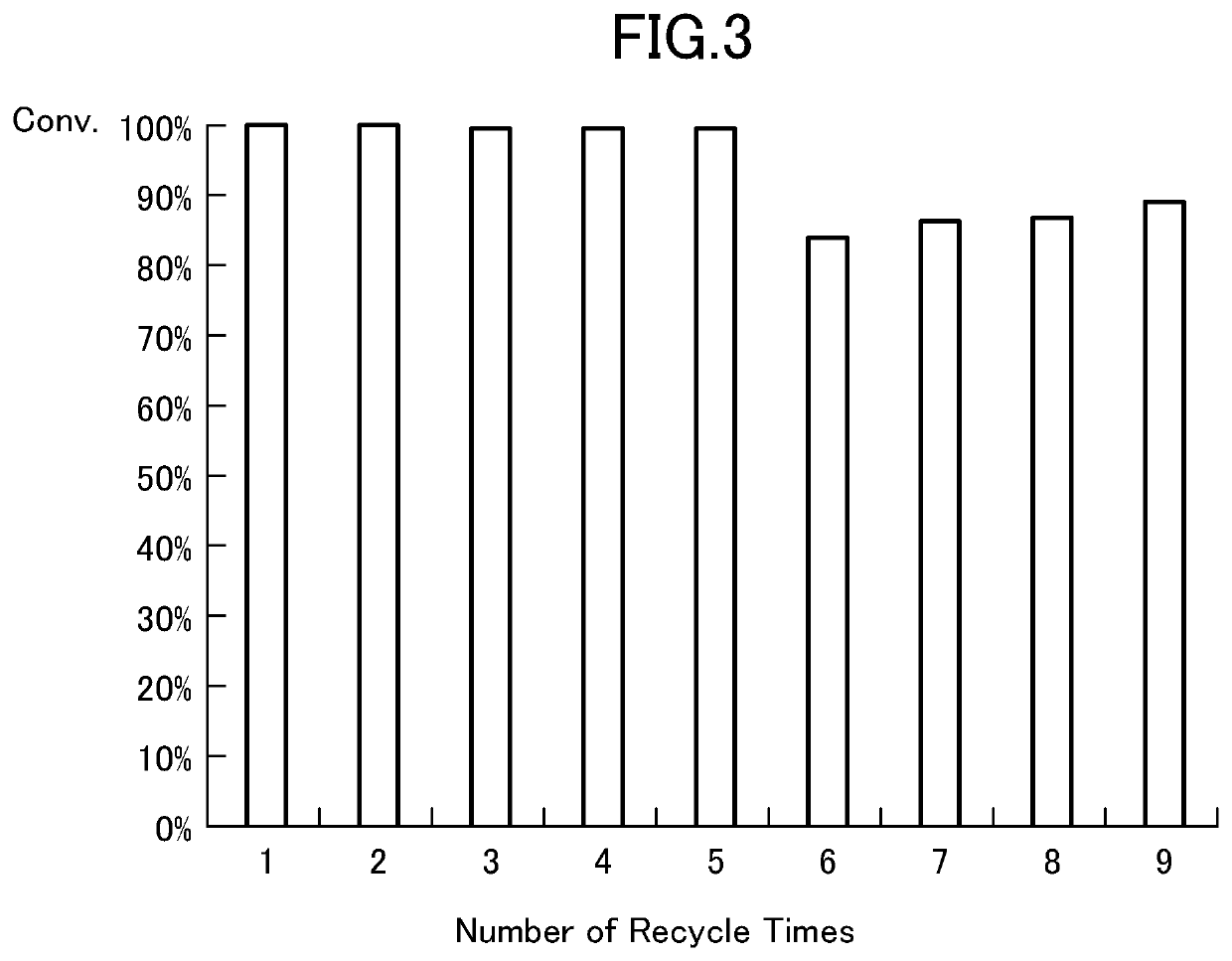Polymer-supported metal
a polymer and metal technology, applied in the field of polymer-supported metals, can solve the problems of difficult removal of zinc catalysts depending on solvents, undefined chemical structures of solid catalysts, and problems such as recycling of catalysts, and achieve the effects of improving the chemical structure of solid catalysts, improving the chemical stability, and improving the chemical stability
- Summary
- Abstract
- Description
- Claims
- Application Information
AI Technical Summary
Benefits of technology
Problems solved by technology
Method used
Image
Examples
examples
[0112]Hereinafter, the present invention will be described in detail based on Examples; however, the present invention is not limited thereto. Note that analytical instruments were as described below. In addition, all the operations in Examples were conducted under a nitrogen atmosphere.[0113]Thermal analysis: EXSTAR 6000 TG / DTA 6200 (SII), measuring range: 30 to 600° C., heating speed: 6° C. / min, measured amount: approximately 5 mg, sample pan: aluminum, atmosphere: nitrogen (10 mL / min) or in vacuum (2 Torr)[0114]The metal content was determined by a titration method (“Kireto Tekitei (Chelate titration),” authored by Keihei Ueno (Nankodo Co., Ltd.)).[0115]Chloromethyl polystyrene resin 1% DVB (divinylbenzene) cross-linked resin (Merrifield Resin cross-linked with 1% DVB (200-400 mesh)) (hereinafter, abbreviated as CH2-Polymer)[0116]Zinc trifluoroacetate hydrate (manufactured by Alfa Aesar, zinc content: 21.24% (zinc titration measurement)) (hereinafter, abbreviated as Zn(OAcF)2)[01...
examples 2 to 6
[0127]Polymer-supported zinc trifluoroacetate were synthesized under various conditions in the same manner as in Example 1. Table 1 below shows the results of Examples 1 to 6.
[0128]
TABLE 1Im-CH2-ZincPolymer-PolymerZn(OAcF)2AtomssupportedExample(g)(g)(mmol)Solventzinc (g)11.000.300.97THF1.1620.500.491.58THF0.5831.000.100.33THF1.0240.990.300.97i-PrOH1.2851.000.310.99n-BuOH1.2760.990.030.11THF0.97
(Examples 7 to 12) Synthesis of Polymer-Supported Other Metal Inorganic Salt
[0129]Polymer-supported other metal inorganic salt were synthesized. To im-CH2-Polymer synthesized in Reference Example 1, each metal inorganic salt was added, and the mixture was refluxed in a reaction solvent under nitrogen for 5 hours, and then cooled to room temperature and filtered. The filtration residue was washed three times with tetrahydrofuran, and further once with heptane. The obtained solid substance was placed in a Schlenk tube, and dried under heating at 65° C. in a vacuum to obtain polymer-supported the...
example 14
(Example 14) Comparison of Catalytic Activities with Various Imidazolyl Group Contents
[0134]Table 4 shows the results of a comparison of the effect of adding zinc trifluoroacetate by using three types of im-CH2-Polymer having different imidazole-supporting amounts. To 1 equivalent of methyl benzoate and 1.2 equivalents of benzyl alcohol, 5% by mole (in terms of zinc atoms) of zinc trifluoroacetate and im-CH2-Polymer synthesized in Reference Example 1 at various ratio relative to the zinc atoms were added, and transesterification reaction was conducted by reflux in toluene solvent (0.5 M) for 2 hours. Table 4 below shows the results of the yield of methyl benzoate measured by gas chromatography (GC). It was found that the conversion was high, when the ratio (im / Zn) of the imidazolyl groups in the imidazolyl-supporting resin relative to the zinc atoms was 4 or higher. It was found that im-CH2-Polymer containing imidazolyl groups at a higher ratio of 4.98 mmol / g had lower activity than...
PUM
| Property | Measurement | Unit |
|---|---|---|
| temperature | aaaaa | aaaaa |
| temperature | aaaaa | aaaaa |
| temperature | aaaaa | aaaaa |
Abstract
Description
Claims
Application Information
 Login to View More
Login to View More - R&D
- Intellectual Property
- Life Sciences
- Materials
- Tech Scout
- Unparalleled Data Quality
- Higher Quality Content
- 60% Fewer Hallucinations
Browse by: Latest US Patents, China's latest patents, Technical Efficacy Thesaurus, Application Domain, Technology Topic, Popular Technical Reports.
© 2025 PatSnap. All rights reserved.Legal|Privacy policy|Modern Slavery Act Transparency Statement|Sitemap|About US| Contact US: help@patsnap.com



